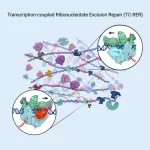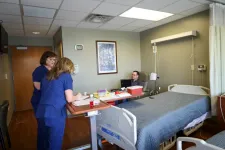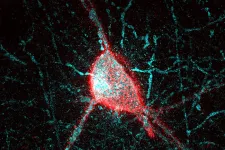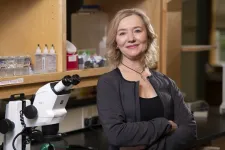(Press-News.org) CAMBRIDGE, MA -- Inspired by sutures developed thousands of years ago, MIT engineers have designed “smart” sutures that can not only hold tissue in place, but also detect inflammation and release drugs.
The new sutures are derived from animal tissue, similar to the “catgut” sutures first used by the ancient Romans. In a modern twist, the MIT team coated the sutures with hydrogels that can be embedded with sensors, drugs, or even cells that release therapeutic molecules.
“What we have is a suture that is bioderived and modified with a hydrogel coating capable of being a reservoir for sensors for inflammation, or for drugs such as monoclonal antibodies to treat inflammation. Remarkably, the coating also has the capacity to retain cells that are viable for a prolonged period,” says Giovanni Traverso, an associate professor of mechanical engineering at MIT, a gastroenterologist at Brigham and Women’s Hospital, and the senior author of the study.
The researchers envision that these sutures could help patients with Crohn’s disease heal after surgery to remove part of the intestine. The sutures could also be adapted for use to heal wounds or surgical incisions elsewhere in the body, the researchers say.
Former MIT postdocs Jung Seung Lee and Hyunjoon Kim are the lead authors of the paper, which appears today in the journal Matter.
Inspired by catgut
Catgut sutures — which are made from strands of purified collagen from cows, sheep, or goats (but not cats) — form strong knots that naturally dissolve within about 90 days. Although synthetic absorbable sutures are also available, catgut is still used in many types of surgery.
Traverso and his colleagues wanted to see if they could build on this type of tissue-derived suture to create a material that would be tough and absorbable, and have advanced functions such as sensing and drug delivery.
Such sutures could be particularly useful for Crohn’s disease patients who need to have a part of the intestine removed due to blockage from excessive scarring or inflammation. This procedure requires resealing the two ends left behind after one section of the intestine is removed. If that seal doesn’t hold tightly, it can lead to leaks that are dangerous for the patient.
To help reduce this risk, the MIT team wanted to design a suture that could not only hold the tissue in place but also detect inflammation, an early warning sign that the resealed intestines are not healing properly.
The researchers created their new sutures from pig tissue, which they “decellularized” using detergents, to reduce the chances of inducing inflammation in the host tissue. This process leaves behind a cell-free material that the researchers call “De-gut,” which contains structural proteins such as collagen, as well as other biomolecules found in the extracellular matrix that surrounds cells.
After dehydrating the tissue and twisting it into strands, the researchers evaluated its tensile strength — a measure of how much stretching it can withstand before breaking — and found that it was comparable to commercially available catgut sutures. They also found that the De-gut sutures induce much less of an immune response from surrounding tissue than traditional catgut.
“Decellularized tissues have been extensively used in regenerative medicine with their superb biofunctionality,” Lee says. “We now suggest a novel platform for performing sensing and delivery using decellularized tissue, which will open up new applications of tissue-derived materials.”
Smart applications
Next, the researchers set out to enhance the suture material with additional functions. To do that, they coated the sutures with a layer of hydrogel. Within the hydrogel, they can embed several types of cargo — microparticles that can sense inflammation, various drug molecules, or living cells.
For the sensor application, the researchers designed microparticles coated with peptides that are released when inflammation-associated enzymes called MMPs are present in the tissue. Those peptides can be detected using a simple urine test.
The researchers also showed that they could use the hydrogel coating to carry drugs that are used to treat inflammatory bowel disease, including a steroid called dexamethasone and a monoclonal antibody called adalimumab. These drugs were carried by microparticles made from FDA-approved polymers such as PLGA and PLA, which are used to control the release rate of drugs. This approach could also be adapted to deliver other kinds of drugs such as antibiotics or chemotherapy drugs, the researchers say.
These smart sutures could also be used to deliver therapeutic cells such as stem cells. To explore that possibility, the researchers embedded the sutures with stem cells engineered to express a fluorescent marker, and found that the cells remained viable for at least seven days when implanted in mice. The cells were also able to produce vascular endothelial growth factor (VEGF), a growth factor that stimulates blood cell growth.
The researchers are now working on further testing each of these possible applications, and on scaling up the manufacturing process for the sutures. They also hope to explore the possibility of using the sutures in parts of the body other than the gastrointestinal tract.
Other authors of the paper are Gwennyth Carroll, Gary Liu, Ameya Kirtane, Alison Hayward, Adam Wentworth, Aaron Lopes, Joy Collins, Siid Tamang, Keiko Ishida, Kaitlyn Hess, Junwei Li, and Sufeng Zhang.
###
The research was funded by the Leona M. and Harry B. Helmsley Charitable Trust, the MIT Department of Mechanical Engineering, the National Research Foundation of Korea, and a National Institute of Diabetes and Digestive and Kidney Disease Ruth L. Kirschstein NRSA Fellowship.
END
Engineers design sutures that can deliver drugs or sense inflammation
The bioderived “smart sutures” could help patients heal after bowel resection or other types of surgery.
2023-05-16
ELSE PRESS RELEASES FROM THIS DATE:
Integration of AI decision aids to reduce workload and enhance efficiency in thyroid nodule management
2023-05-16
About The Study: The results of this diagnostic study involving 16 radiologists and 2,054 ultrasonographic images suggest that an optimized artificial intelligence (AI) strategy in thyroid nodule management may reduce diagnostic time-based costs without sacrificing diagnostic accuracy for senior radiologists, while the traditional all-AI strategy may still be more beneficial for junior radiologists.
Authors: Wei Wang, M.D., Ph.D., of Sun Yat-sen University in Guangzhou, China, is the corresponding author.
To access the embargoed study: Visit our For The Media website at this link ...
Use of immunization information systems in ascertainment of COVID-19 vaccinations for claims-based vaccine safety and effectiveness studies
2023-05-16
About The Study: The findings of this study of 5.1 million individuals suggested that supplementing COVID-19 claims records with Immunization Information Systems vaccination records substantially increased the number of individuals who were identified as vaccinated, yet potential under-recording remained. Improvements in reporting vaccination data to Immunization Information Systems infrastructures could allow frequent updates of vaccination status for all individuals and all vaccines.
Authors: Karen Schneider, Ph.D., of OptumServe Consulting in Falls ...
Estimated rates of incident and persistent chronic pain among US adults
2023-05-16
About The Study: In this analysis of nationally representative survey data, the incidence of chronic pain was high compared with other chronic diseases and conditions for which the incidence in the U.S. adult population is known, including diabetes, depression, and hypertension. This comparison emphasizes the high disease burden of chronic pain in the U.S. adult population and the need for both prevention and early management of pain before it can become chronic, especially for groups at higher risk.
Authors: Richard L. Nahin, M.P.H., Ph.D., of the National Institutes of Health in Bethesda, Maryland, is the corresponding author.
To access ...
Moving from distressed areas to better-resourced neighborhoods improves kids’ asthma
2023-05-16
Children whose families participated in a program that helped them move from distressed neighborhoods to areas with lower rates of poverty and better public resources like schools and parks experienced significant improvements in severe asthma episodes, according to a new study led by a researcher at Dell Medical School at The University of Texas at Austin.
The study, published today in the Journal of the American Medical Association, involved 123 children, ages 5 to 17, with persistent asthma whose families took part in a six-year housing mobility program in Baltimore.
Before ...
Researchers reveal DNA repair mechanism
2023-05-16
A new study adds to an emerging, radically new picture of how bacterial cells continually repair faulty sections of their DNA.
Published online May 16 in the journal Cell, the report describes the molecular mechanism behind a DNA repair pathway that counters the mistaken inclusion of a certain type of molecular building block, ribonucleotides, into genetic codes. Such mistakes are frequent in code-copying process in bacteria and other organisms. Given that ribonucleotide misincorporation can result in detrimental DNA code changes (mutations) and DNA breaks, all organisms have ...
Three professional societies unite on National Science Foundation grant in effort to increase access and inclusivity in ornithology
2023-05-16
CHICAGO — May 16, 2023 — The landscape of science is changing: People from increasingly varied backgrounds, identities, cultures, and genders are pursuing careers in STEM (science, technology, engineering, and mathematics) fields. Support for this more diverse population of scientists needs to extend beyond “one size fits all” to better meet the needs of today’s scientists. Expanding support and strengthening the sense of community for individuals and groups who have not been historically welcomed in a discipline can foster a deeper sense of belonging and meaningfully broaden representation within that field. Researchers ...
NIH launches largest precision nutrition research effort of its kind
2023-05-16
The National Institutes of Health is now enrolling participants in a landmark initiative to advance nutrition research. Nutrition for Precision Health, powered by the All of Us Research Program, or NPH, is working with 14 sites across the United States – including Pennington Biomedical Research Center and LSU Health Sciences New Orleans in Louisiana – to engage 10,000 participants from diverse backgrounds and learn more about how our bodies respond differently to food.
“Nutrition for Precision Health brings us a step closer to precision medicine. The study will generate a massive ...
Study first to examine how early memory changes as we age at a cellular level
2023-05-16
How do our brains become capable of creating specific memories? In one of the first preclinical studies to examine memory development in youth, a research team at The Hospital for Sick Children (SickKids) may have identified a molecular cause for memory changes in early childhood.
Event-based memories, also known as episodic memories, are what people traditionally think of when they hear the word memory: a recollection tied to a specific context. For young children, however, memory is more general or “gist”-like, and these general recollections are typically not tied to a specific context.
In a study published in ...
New paper introduces ethics framework for use of Generative AI in healthcare
2023-05-16
A new paper published by leading Australian AI ethicist Stefan Harrer PhD proposes for the first time a comprehensive ethical framework for the responsible use, design, and governance of Generative AI applications in healthcare and medicine.
The peer-reviewed study published in The Lancet’s eBioMedicine journal details how Large Language Models (LLMs) have the potential to fundamentally transform information management, education, and communication workflows in healthcare and medicine but equally remain one of the most dangerous and misunderstood types of AI.
“LLMs used to be boring and safe. They have become exciting ...
Accomplished molecular biologist to lead new group at MDI Biological Laboratory
2023-05-16
Halyna Shcherbata, Ph.D., will lead a new research group at MDI Biological Laboratory, in the Kathryn W. Davis Center for Regenerative Biology and Aging. Shcherbata's work has focused on regulatory and other roles of non-coding microRNA in gene expression and maintenance, and disorders such as muscular dystrophy and developmental delay. She is already developing new facilities for Drosophila melanogaster fruit flies on campus, returning an esteemed stand-in for human physiology to the Laboratory’s roster of animal models.
In her new lab on Maine's Mt. Desert ...
LAST 30 PRESS RELEASES:
HBNU researchers propose novel sensor-integrated wrapper for food quality monitoring and preservation
Role of ubiquilin-2 liquid droplets in α-synuclein aggregation
Hanyang University researchers proposed novel technology for environmental infringement and sag estimation for transmission lines
Pro fighters risk damage to the brain’s ‘garbage disposal’
AI tops density in predicting breast cancer risk
Pesticides and other common chemical pollutants are toxic to our ‘good’ gut bacteria
Chemists design OLEDs that electrically flip the handedness of light
Experimental mRNA therapy shows potential to combat antibiotic-resistant infections
New mutation hotspot discovered in human genome
New deep-learning tool can tell if your salmon is wild or farmed
If you're over 60 and playing with sex toys, you're not alone
Fame itself may be critical factor in shortening singers’ lives
Daily coffee drinking may slow biological ageing of people with major mental illness
New highly efficient material turns motion into power – without toxic lead
The DEVILS in the details: New research reveals how the cosmic landscape impacts the galaxy lifecycle
After nearly 100 years, scientists may have detected dark matter
Gender imbalance hinders equitable environmental governance, say UN scientists
Six University of Tennessee faculty among world’s most highly cited researchers
A type of immune cell could hold a key to preventing scar tissue buildup in wounds
Mountains as water towers: New research highlights warming differences between high and low elevations
University of Tennessee secures $1 million NSF grant to build semiconductor workforce pipeline
Biochar shows powerful potential to build cleaner and more sustainable cities worldwide
UT Health San Antonio leads $4 million study on glucagon hormone’s role in diabetes, obesity
65-year-old framework challenged by modern research
AI tool helps visually impaired users ‘feel’ where objects are in real time
Collaborating minds think alike, processing information in similar ways in a shared task
Routine first trimester ultrasounds lead to earlier detection of fetal anomalies
Royal recognition for university’s dementia work
It’s a bird, it’s a drone, it’s both: AI tech monitors turkey behavior
Bormioli Luigi renews LionGlass deal with Penn State after successful trial run
[Press-News.org] Engineers design sutures that can deliver drugs or sense inflammationThe bioderived “smart sutures” could help patients heal after bowel resection or other types of surgery.




